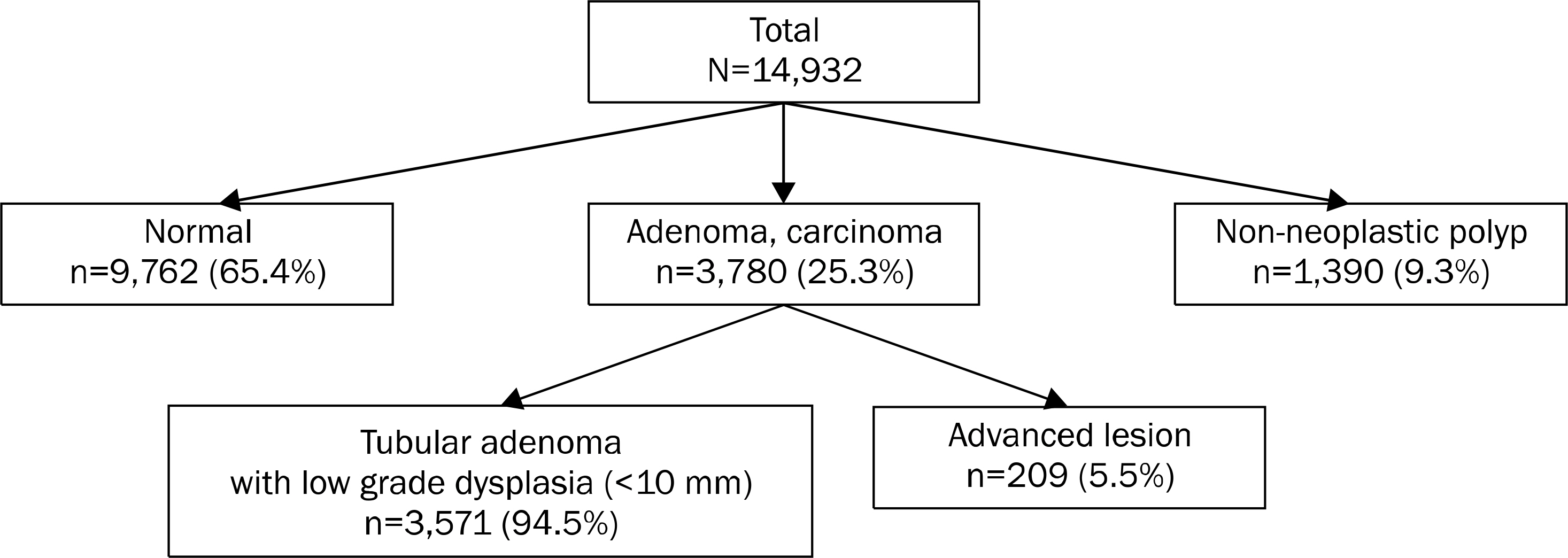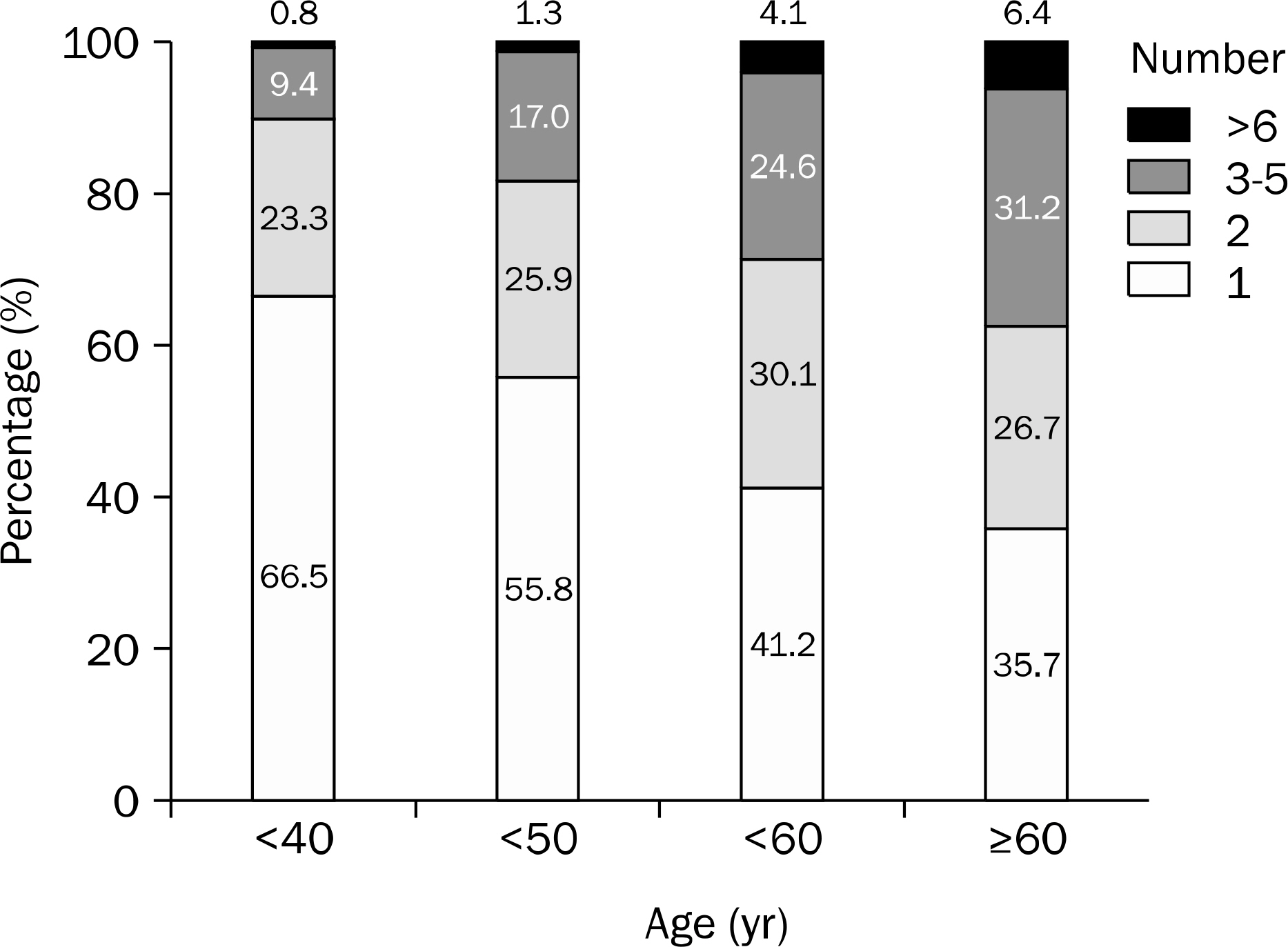Korean J Gastroenterol.
2013 Aug;62(2):104-110. 10.4166/kjg.2013.62.2.104.
Prevalence and Risk Factors of Colorectal Adenoma in 14,932 Koreans Undergoing Screening Colonoscopy
- Affiliations
-
- 1Health Promotion Center, Gangnam Severance Hospital, Yonsei University College of Medicine, Seoul, Korea. aderheesun@yuhs.ac
- KMID: 1775747
- DOI: http://doi.org/10.4166/kjg.2013.62.2.104
Abstract
- BACKGROUND/AIMS
Current international guidelines recommend colorectal cancer screening for average-risk people over 50 years of age. Accordingly, we aimed to estimate the prevalence of colorectal neoplasms in all age groups and evaluate associated risk factors.
METHODS
Data of 14,932 subjects who underwent colonoscopy from July 2006 to January 2012 at Health Promotion Center, Gangnam Severance Hospital (Seoul, Korea) as part of a health check-up were reviewed retrospectively.
RESULTS
The overall prevalence of colorectal neoplasms and adenoma were 34.6% and 25.3%, respectively. Colorectal adenoma was found in 3.2%, 13.0%, 21.7%, 33.8%, 44.0%, 50.5%, and 54.2% of subjects under 30 years, 30-39 years, 40-49 years, 50-59 years, 60-69 years, 70-79 years, and over 80 years of age (trend p<0.0001). Independent predictors of colorectal adenoma included male gender (OR 2.38, 95% CI 2.084-2.718), positive occult blood (2.266, 1.761-2.917), positive serology of Helicobacter pylori (1.253, 1.114-1.409) and hypertriglyceremia (1.267, 1.065-1.508). Compared to the 30-39 years of age reference group, the ORs for each age group were 0.195 (under 30 years), 1.634 (40-49 years), 2.954 (50-59 years), 5.159 (60-69 years), 5.640 (70-79 years), 11.020 (over 80 years), while the 95% CIs were 0.071-0.536 (under 30 years), 1.340-1.992 (40-49 years), 2.421-3.604 (50-59 years), 4.109-6.476 (60-69 years), 3.822-8.322 (70-79 years), and 2.809-42.234 (over 80 years).
CONCLUSIONS
Colorectal adenoma prevalence increased proportionally with age. Only subjects under the age of 30 years had a definitely lower prevalence of colorectal adenoma. Male gender, positive occult blood, positive serology of H. pylori, and hypertriglyceremia were associated risk factors of colorectal adenoma.
MeSH Terms
-
Adenoma/*epidemiology/etiology
Adult
Age Factors
Aged
Aged, 80 and over
Asian Continental Ancestry Group
Colonoscopy
Colorectal Neoplasms/*epidemiology/etiology
Female
Helicobacter Infections/complications
Helicobacter pylori
Humans
Hypertriglyceridemia/complications
Logistic Models
Male
Middle Aged
Odds Ratio
Republic of Korea/epidemiology
Retrospective Studies
Sex Factors
Figure
Reference
-
References
1. Jung KW, Park S, Kong HJ, et al. Cancer statistics in Korea: incidence, mortality, survival, and prevalence in 2008. Cancer Res Treat. 2011; 43:1–11.
Article2. Hill MJ, Morson BC, Bussey HJ. Aetiology of adenoma–carcinoma sequence in large bowel. Lancet. 1978; 1:245–247.3. Vogelstein B, Fearon ER, Hamilton SR, et al. Genetic alterations during colorectal-tumor development. N Engl J Med. 1988; 319:525–532.
Article4. Chung SJ, Kim YS, Yang SY, et al. Prevalence and risk of colorectal adenoma in asymptomatic Koreans aged 40–49 years undergoing screening colonoscopy. J Gastroenterol Hepatol. 2010; 25:519–525.5. Chung YW, Han DS, Park YK, et al. Association of obesity, serum glucose and lipids with the risk of advanced colorectal adenoma and cancer: a casecontrol study in Korea. Dig Liver Dis. 2006; 38:668–672.
Article6. Boursi B, Halak A, Umansky M, Galzan L, Guzner-Gur H, Arber N. Colonoscopic screening of an average-risk population for colorectal neoplasia. Endoscopy. 2009; 41:516–521.
Article7. Kim Y, Jun JK, Choi KS, Lee HY, Park EC. Overview of the national cancer screening programme and the cancer screening status in Korea. Asian Pac J Cancer Prev. 2011; 12:725–730.8. Lee BI, Hong SP, Kim SE, et al. MultiSociety Task Force for Development of Guidelines for Colorectal Polyp Screening, Surveillance and Management. Korean guidelines for colorectal cancer screening and polyp detection. Korean J Gastroenterol. 2012; 59:65–84.
Article9. Chobanian AV, Bakris GL, Black HR, et al. The seventh report of the joint National Committee on Prevention, Detection, Evaluation, and Treatment of High Blood Pressure: the JNC 7 report. JAMA. 2003; 289:2560–2572.
Article10. Levin B, Lieberman DA, McFarland B, et al. Screening and surveillance for the early detection of colorectal cancer and adenomatous polyps, 2008: a joint guideline from the American Cancer Society, the US MultiSociety Task Force on Colorectal Cancer, and the American College of Radiology. Gastroenterology. 2008; 134:1570–1595.
Article11. Rondagh EJ, Bouwens MW, Riedl RG, et al. Endoscopic appearance of proximal colorectal neoplasms and potential implications for colonoscopy in cancer prevention. Gastrointest Endosc. 2012; 75:1218–1225.
Article12. Betés M, Muñoz-Navas MA, Duque JM, et al. Use of colonoscopy as a primary screening test for colorectal cancer in average risk people. Am J Gastroenterol. 2003; 98:2648–2654.
Article13. Byeon JS, Yang SK, Kim TI, et al. Asia Pacific Working Group for Colorectal Cancer. Colorectal neoplasm in asymptomatic Asians: a prospective multinational multicenter colonoscopy survey. Gastrointest Endosc. 2007; 65:1015–1022.
Article14. Liu HH, Wu MC, Peng Y, Wu MS. Prevalence of advanced colonic polyps in asymptomatic Chinese. World J Gastroenterol. 2005; 11:4731–4734.
Article15. Soon MS, Kozarek RA, Ayub K, Soon A, Lin TY, Lin OS. Screening colonoscopy in Chinese and Western patients: a comparative study. Am J Gastroenterol. 2005; 100:2749–2755.
Article16. Leung WK, Ho KY, Kim WH, et al. Asia Pacific Working Group on Colorectal Cancer. Colorectal neoplasia in Asia: a multicenter colonoscopy survey in symptomatic patients. Gastrointest Endosc. 2006; 64:751–759.
Article17. Youn SJ, Kim NY, Kim YT, et al. Colorectal polyp in Korea. Korean J Gastroenterol. 1991; 23:450–458.18. Park DI, Kim YH, Kim HS, et al. Diagnostic yield of advanced colorectal neoplasia at colonoscopy, according to indications: an investigation from the Korean Association for the Study of Intestinal Diseases (KASID). Endoscopy. 2006; 38:449–455.
Article19. Park HW, Byeon JS, Yang SK, et al. Colorectal neoplasm in asymptomatic average-risk Koreans: The KASID prospective multicenter colonoscopy survey. Gut Liver. 2009; 3:35–40.
Article20. Hong SN, Yang DH, Kim YH, et al. MultiSociety Task Force for-Development of Guidelines for Colorectal Polyp Screening, Surveillance and Management. Korean guidelines for post-polypectomy colonoscopic surveillance. Korean J Gastroenterol. 2012; 59:99–117.
Article21. Kim JH, Lim YJ, Kim YH, et al. Is metabolic syndrome a risk factor for colorectal adenoma? Cancer Epidemiol Biomarkers Prev. 2007; 16:1543–1546.
Article22. Kim YJ, Lee KM, Chung WC, Paik CN, Jung SH. Association between measures of obesity and colorectal adenoma. Chin Med J (Engl). 2011; 124:3711–3715.23. Sun ZJ, Huang YH, Wu JS, et al. The association of serum lipids with the histological pattern of rectosigmoid adenoma in Taiwanese adults. BMC Gastroenterol. 2011; 11:54.
Article24. Tabuchi M, Kitayama J, Nagawa H. Hypertriglyceridemia is positively correlated with the development of colorectal tubular adenoma in Japanese men. World J Gastroenterol. 2006; 12:1261–1264.
Article25. Lee HL, Son BK, Lee OY, et al. Abdominal obesity, insulin resistance, and the risk of colonic adenoma. Korean J Gastroenterol. 2007; 49:147–151.26. Aaronson SA. Growth factors and cancer. Science. 1991; 254:1146–1153.
Article27. Giovannucci E. Insulin, insulin-like growth factors and colon cancer: a review of the evidence. J Nutr. 2001; 131(11 Suppl):3109S–3120S.
Article28. Abbass K, Gul W, Beck G, Markert R, Akram S. Association of Helicobacter pylori infection with the development of colorectal polyps and colorectal carcinoma. South Med J. 2011; 104:473–476.29. Aydin A, Karasu Z, Zeytinoglu A, Kumanlioglu K, Ozacar T. Colorectal adenomateous polyps and Helicobacter pylori infection. Am J Gastroenterol. 1999; 94:1121–1122.30. Breuer-Katschinski B, Nemes K, Marr A, et al. Helicobacter pylori and the risk of colonic adenomas. Colorectal Adenoma Study Group. Digestion. 1999; 60:210–215.31. Moss SF, Neugut AI, Garbowski GC, Wang S, Treat MR, Forde KA. Helicobacter pylori seroprevalence and colorectal neoplasia: evidence against an association. J Natl Cancer Inst. 1995; 87:762–763.32. Hong SN, Lee SM, Kim JH, et al. Helicobacter pylori infection increases the risk of colorectal adenomas: cross-sectional study and metaanalysis. Dig Dis Sci. 2012; 57:2184–2194.33. Zhao YS, Wang F, Chang D, Han B, You DY. Meta-analysis of different test indicators: Helicobacter pylori infection and the risk of colorectal cancer. Int J Colorectal Dis. 2008; 23:875–882.34. Sonnenberg A, Genta RM. Helicobacter pylori is a risk factor for colonic neoplasms. Am J Gastroenterol. 2013; 108:208–215.35. Thorburn CM, Friedman GD, Dickinson CJ, Vogelman JH, Oren-treich N, Parsonnet J. Gastrin and colorectal cancer: a prospective study. Gastroenterology. 1998; 115:275–280.
Article36. Jones M, Helliwell P, Pritchard C, Tharakan J, Mathew J. Helicobacter pylori in colorectal neoplasms: is there an aetiological relationship? World J Surg Oncol. 2007; 5:51.
Article37. Shmuely H, Passaro D, Figer A, et al. Relationship between Helicobacter pylori CagA status and colorectal cancer. Am J Gastroenterol. 2001; 96:3406–3410.38. Lee SH, Lee KS, Lee JY, et al. Clinical usefulness of fecal occult blood test as a screening method for asymptomatic patients with colon polyps. Korean J Gastroenterol. 2006; 48:388–394.39. Nakama H, Abdul Fattah AS, Zhang B, Kamijo N, Fujimori K, Miyata K. Detection rate of immunochemical fecal occult blood test for colorectal adenomatous polyps with severe dysplasia. J Gastroenterol. 1997; 32:492–495.
Article
- Full Text Links
- Actions
-
Cited
- CITED
-
- Close
- Share
- Similar articles
-
- Association of Gallbladder Polyp with the Risk of Colorectal Adenoma
- Is Preoperative Work-Up Colonoscopy Necessary for Patient with Gastric Cancer?
- Results of Screening Colonoscopy in Asymptomatic Average-risk Koreans at a Community-based Secondary Hospital
- Strategies for colorectal cancer screening and post-polypectomy surveillance for young adults under age 50
- Colon Cancer Screening with Image-Enhanced Endoscopy




